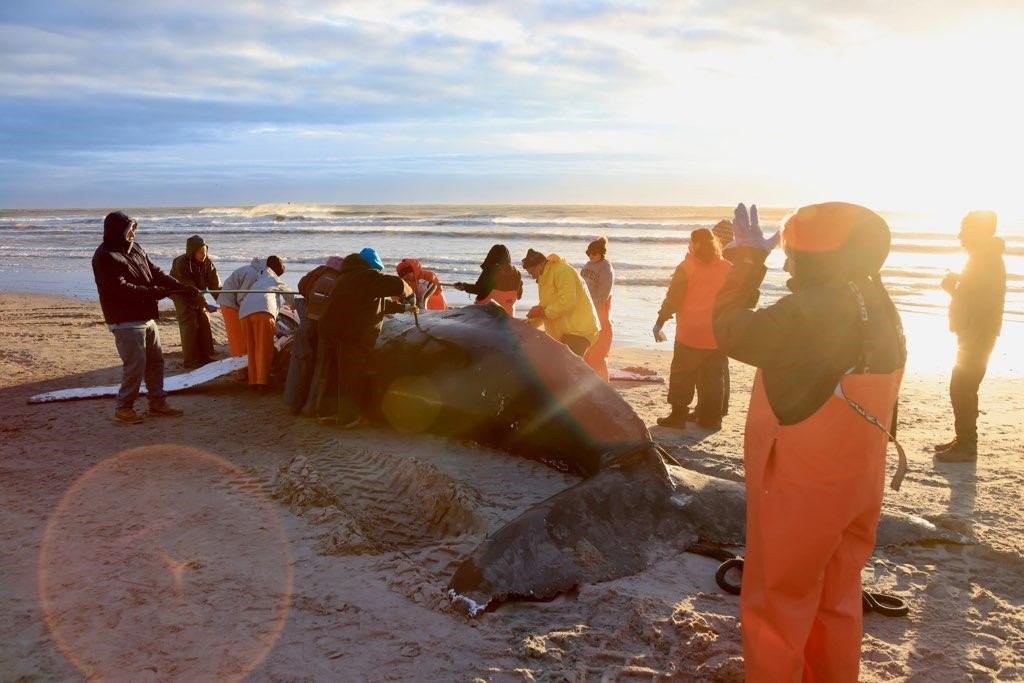U.S. fisheries and offshore energy officials said there is no evidence to support allegations that offshore survey work for wind power development might be a factor in more than a dozen dead whales washing up on East Coast beaches in the last six weeks.
The discovery of 14 dead whales, mostly humpbacks, since Dec.1 may be part of a larger “unusual mortality event” among Atlantic humpbacks that started in January 2016, and to date counts 178 animals, officials with the National Oceanic and Atmospheric Administration and Bureau of Ocean Energy Management said in a Jan. 18 briefing with reporters.
The strandings of two dead humpback whales at Atlantic City, N.J., in December brought protests from groups opposed to offshore wind energy projects, who contend the animals could have been harmed by vessels that tow survey equipment and sample the sea floor for developers planning to install wind turbines and power cables off New Jersey.
Agency representatives said there is no evidence to support those claims.
“I want to be unambiguous: There is no information supporting that any of the equipment used in support of offshore wind development could directly lead to the death of a whale,” said Benjamin Laws, deputy chief for permits and conservation with NOAA Fisheries Office of Protected Resources.
Offshore wind critics question if sounds from survey equipment could be harming whales. BOEM officials – who oversee offshore oil and gas development as well in the Gulf of Mexico – said the survey tools used for wind projects off the East Coast are akin to sonar rather than the loud acoustic signals used for oil exploration.
Seismic “air guns” towed behind survey vessels during oil and gas exploration “are very high energy” intended to penetrate kilometers under the seabed to chart geologic formations, said Erica Staaterman of BOEM's Center for Marine Acoustics.
By contrast high resolution geophysical survey systems used for wind power surveys generate sound in short bursts of milliseconds, at longer intervals around 15 seconds, in narrow beams of sound that affect much smaller areas in the ocean than air guns, said Staaterman.
Baleen whales like humpbacks – named for the filter-feeding structures in their mouths – are sensitive to lower sound frequencies. Most survey systems generate sound in mid- to higher frequencies, said Staaterman.
“It’s important to keep that in mind,” she added. “It’s one of the first things we look at.”
Most of the survey work is looking at the sea floor and underlying “sub-bottom” to help evaluate conditions for building turbine foundations and cable corridors, said Brian Hooker, biology team lead for BOEM’s Office of Renewable Energy Programs.
Such surveys “are commonly used around the world” and there is no history of them causing whale deaths, said Laws of NOAA.
Necropsies on one of the whales found at Atlantic City and another just north in Brigantine, N.J., found evidence the animals had been struck by vessels. Hooker said BOEM requires workboats on offshore wind projects to adhere to speed limits to protect marine mammals.
“We have a pretty rigorous reporting requirement for these vessels,” he said. That includes maintaining observers on board to watch out for whales.
Those rules are a requirement of “incidental take” permits that offshore wind developers get from NOAA, allowing them to conduct activities that could harm whales or disrupt their natural behavior – called “harassment” in the language of the federal Marine Mammal Protection Act.
“It’s a regulatory definition of the Marine Mammal Protection Act,” said Laws. “Incidental means it’s not intentional.” Harassment is further categorized as “level A” that can cause physical harm to an animal, and “level B” for disturbance. Level B is the only one authorized for offshore wind work, he said.
Whale strandings are more common during winter in the mid-Atlantic, and NOAA investigators are looking at trends including climate change that is affecting how whales and their fish prey are changing their patterns off the East Coast.
“Unfortunately it’s been a number of years that we’ve had elevated strandings,” said Sarah Wilkin, coordinator of NOAA’s Marine Mammal Health and Stranding Response Program.
The humpback whale population has grown off the East Coast, and their favored food like menhaden are swimming closer to shore in recent seasons. That can be exposing them to more risk of collision with coastwise vessel traffic, from seasonal recreational boats and year-round commercial ship, tug and barge traffic.
NOAA regularly issues advisories to the maritime industry for large ships to slow down when approaching areas where whales are known to be active – especially the highly endangered North Atlantic right whale population, now estimated at only around 340 animals.
The agency is also proposing a rule to extend slow-speed limits in its whale warning areas to smaller vessels under 65 feet – a measure that alarms coastal ferry operators, party and charter fishing boat captains who say it could severely limit their operations.
The Atlantic City whale strandings set off an ongoing public relations battle among wind power skeptics, environmental groups that support wind power development, and fishermen, waged on social media and escalating to national news coverage.
Of the 178 dead humpback whales counted since 2016, some 40 percent were found to have suffered injuries from being hit by vessels or entangled in fishing gear, according to NOAA.
It is often difficult for investigators to determine a definitive cause of death when they examine stranded whales, said Wilkin. Adequately dissecting whales during necropsies requires heavy equipment – often a challenge on remote beach areas – and whale carcasses that are already decayed offer fewer clues to what happened to them, she said.







